Category: SpiceRoute
You are viewing all posts from this category, beginning with the most recent.
Post Bike Tour Quiz
Post Bike Tour Quiz
What country would you be in if I told you the following facts?
- 90% of the people are home owners, 10% are renters and 0% are homeless
- There is no unemployment
- Possession of a firearm is a capital offense
- Possession of drugs is a capital offense
- Universal helthcare
- You cannot buy alchohol (except in a bar) between the hours of 10pm and 7am
- If you have a job lined up your are welcome
- If you are a refugee you are out of luck
- you will pay around 20% of your salary for social security and your employer will contribute another 17% but you don’t pay any income tax.
- If you want to buy an Audi plan on spending around a half million dollars
- You will not see any trash in the streets
- You can leave your bike unlocked or your purse on the table and nobody will steal it.
- Home to the world’s second busiest port
If you thought I was describing some “commie socialist dictatorship” you would be wrong. If you said Singapore, you are correct. I will admit that all of these facts come from our most excellent bike tour guide from Urban Adventures, so some of it could be “fake news” or just a simple embellishment by someone who is very proud of their country. I haven’t fact checked any of it yet. But for as much as we saw some pretty cool parts of Singapore today we heard a lot that really made us think.

Maybe the banner picture gave it away before you even read the question? The Marina Bay Sands hotel is the largest in Singapore and has some very distinctive architecture. A ship on top of the three towers, the hotel is owned by the Sands hotel in Las Vegas. It’s a massive hotel with a casino and mall and botanical gardens and a very distinctive architectural landmark of Singapore. Honestly, the Asian and Middle-Eastern architecure we have seen on this trip make America seem really boring. Hey, lets “make American architecture great again!”
One of the reasons there is no homelessness is that the government provides social housing. For as little as $30 / month for those who qualify you can rent a small 600 square foot apartment. To qualify for the next level of social housing, you have to be married and at least 21 years old in order to qualify for social housing if your job is paying less than $90,000 / year. that may seem like a lot, but it is the average income for Singapore. Once you are in at this level you can stay in for life if you want. Or you can even make improvements and sell your place for a profit later when you want to move into even more expensive private housing.
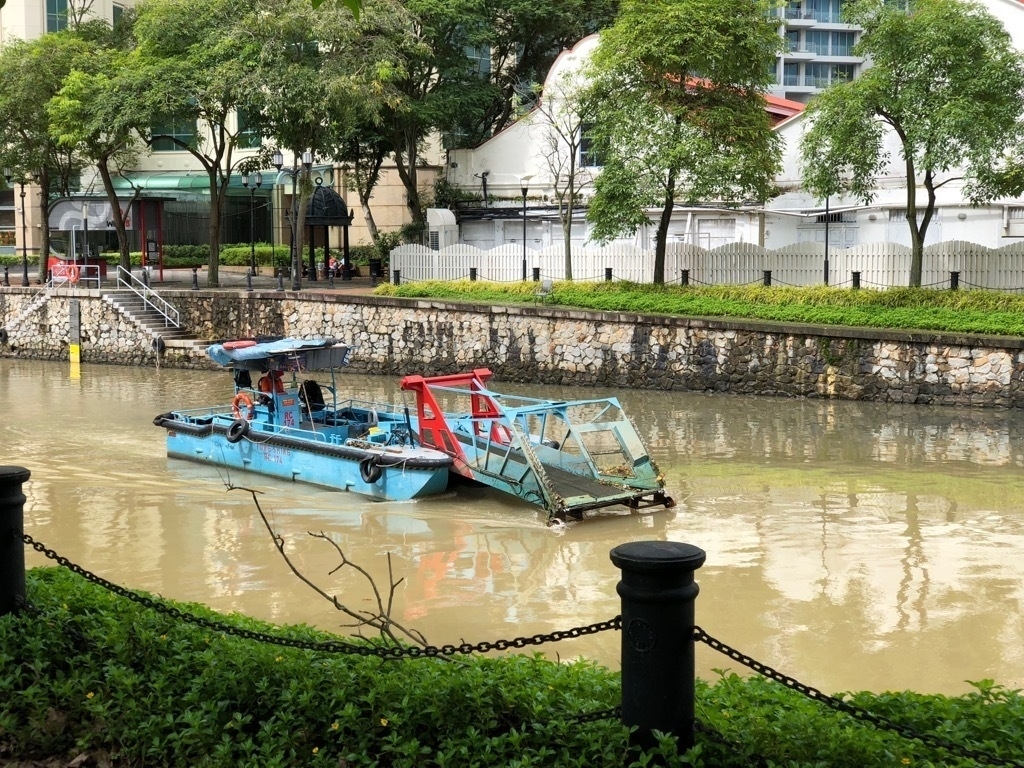
The government is run like a large multi-national corporation. The president makes 4 million a year and if you are elected you can expect to make about a million per year. Our guide put it this way, if you pay peanuts you will only get monkeys. Enough said.

Of course this is all true of a country that has a total population of around 5 million people and is only 278 square miles in size -- That is a bit smaller than New York City. It is home to the world’s second busiest port and the world’s number one airport. The government is run like a business to make money and last year they were 9 billion in the black. I think its easy for an American to look at this wistfully and say what can we learn? Why can’t we be more like this? But I think that is a pretty complicated question that brings into focus our freedoms and our history. I’d be happy to outlaw guns, but I’m not sure sure we should turn away refugees and others in search of a better life. I definitely wouldn’t want to pay half a million for my Audi! But I would support more use of mass transit and more biking in our cities.


Bond, James Bond... Island
Bond, James Bond... Island
Wrong side of the island, wrong end of the beach! That would be the headline for the way our trip started this morning. We got off the ship with a group of 13 that had banded together through Cruise Critic to head off on a swimming, snorkeling and boating trip together. However, it was a bit chaotic at the start. While we could have anchored on the side of the island by the marinas we instead anchored on the other side of the island. And while our guide knew the beach we were supposed to tender into he was informed that we would be tendering to the other end of the beach. So when we got off and started looking for the sign that read “Jane Miller Group” we were suprised to not see one. One taxi driver that had wanted to sell us a tour ended up being particularly nice when he offered to let us use his phone to contact the tour company. They were at the wrong end of the beach which was a long long walk, so they said we should walk to the “family mart” and wait.
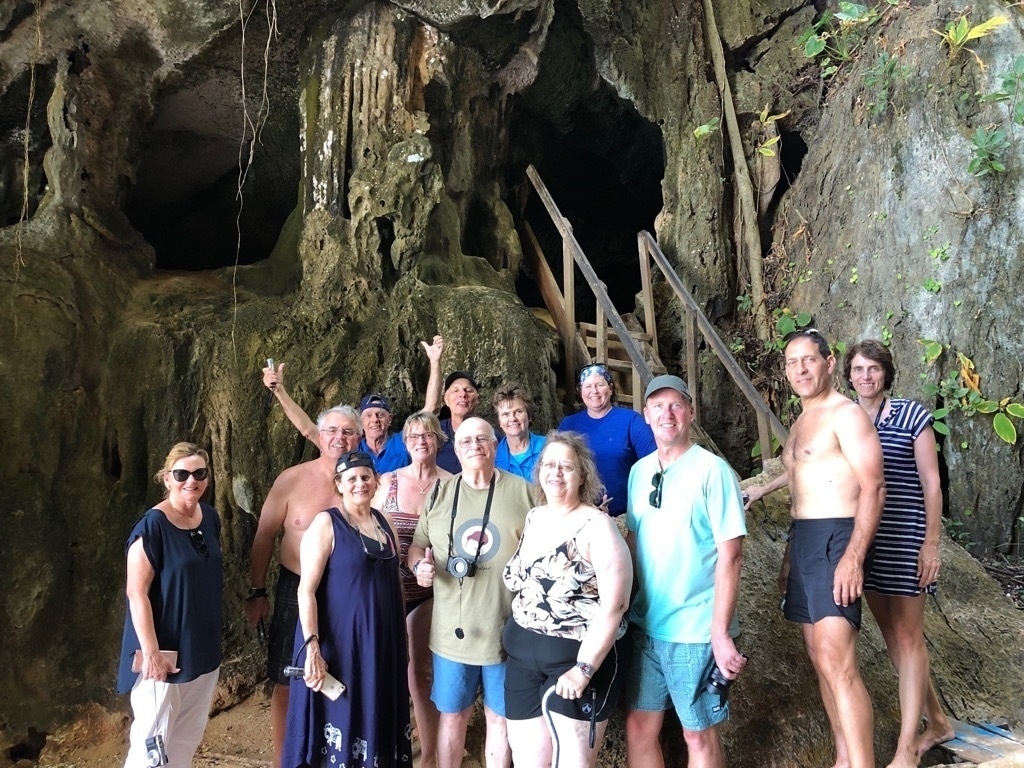
before we even got to the family mart one of our new friends said “Jane, here’s your van”. Sure enough there was a driver with a “Jane Miller” sign. Unfortunately he didn’t have enough room for all of us in the van. So Jane said I should go with the main group and she would wait for a car and ride with our new friends Mike and Karen. Mike is an old army vet who now works as a defense contracter in South Korea teaching war gaming, and Karen is from Austin MN. Although there is a bit of an age gap, we have a lot in common and they were fun to talk to and always up for an adventure.
It was forty five minutes later when we finally arrived at the marina and I had just pulled out my phone and turned on the international plan so I could text jane and find out where she was!? Before I could press the send button however I noticed that she and Mike and Karen were all waiting for us on the sidewalk! OK, mission accomplished, we are all at the marina we can get this show underway. After a short trip to the nearby souvenier store where we paid double the usual cost for our Thai beers and we were ready to board our pink carriage to the boat halfway down the pier.
In our pre-trip briefing, both the owner and our guide for the day assured us that we were going to be back to the dock in plenty of time because they didn’t want anyone to stress about making it back on time for the last tender back to the ship. Great! This sounds good. There is nothing I hate more than wondering if we are going to make it back before the ship leaves.

A half hour later we were at our first stop and in the 85 degree water. Very nice and warm for swimming especially after all of our rushing around this morning and then sitting close together (with life jackets on!! to appease the local authorities) for the first part of the journey. Life jackets were now stowed away for the rest of the trip!

Following the swimming we motored to a group of islands called Phang-Nga bay. These islands were beautiful and reminded us of our time in Halong Bay, Vietnam. We stopped at Ice Cream cave and went spelunking! It was really pretty and brought us through the island where we could see the other side.

We pulled up to a small beach at a national park for lunch. We had a fabulous Thai lunch. By the time we finished lunch it was after 2pm and our guide said we would see James Bond island, the floating village and then do some kayaking before making our way back to the marina at high speed but still an hour away. A few of us began to wonder out loud about the 4:00 return time. It turned out that the tide had gone out and the water was quite shallow to get to the floating village so we had to go slow. I think it was at that point that our guide finally re-did the math in his head and announced that we should choose whether we wanted to see the village or Kayak. None of us could see that Kayaking made any sense, given that we would have had about 5 minutes time to do so. In reality we should have headed back right after James Bond island.

In the end we arrived back at the marina closer to 4:30 and we could tell they were wanting us to really hurry to get to the vans and on our way back to the ship. Given that it had taken 45 minutes to get there in the morning I was wondering how this was going to end. fortunately our afternoon driver seemed to know a much better route than our morning driver and it really only took 20 minutes to get back, so all was well.
Days like today are my one knock against cruises like this. You just don’t really have enough time to do the things you’d like to do without the pressure of going right up against getting on board at the last second. This was true for us in Kuala Lumpur as well as there was a whole hour long drive from the port just to get into the city. When you do a land tour you don’t have those daily deadlines, and you can take your time exploring a bit more.
On the other hand, it was “white night” on the ship tonight and we got back in plenty of time to enjoy the sunset.

Progressive Trivia Champions!
Progressive Trivia Champions!
On our first day at sea we looked at the schedule of activities on board the ship and Jane said, “We should go take a bridge lesson.” Having tried to learn bridge before I thought it sounded like a fun idea, maybe it would stick this time. So we showed up at the appointed time of 10AM and there were a bunch of us. We were among the youngest but certainly not the only people in our age bracket. Our teacher was named Rhoda, clearly a longtime New Yorker. Also a lifelong teacher, she taught reading for most of her career. Most of the other beginners had never even played cards before so I have to give them credit for starting with Bridge. All our nights of 500 were a definite advantage in the playing phase of Bridge. We didn’t even start learning how to bid until the second lesson, but before we knew it we were adding high card points, learning about 5 card major openings, Jacoby transfers, Staymen, forcing bids, no trump responses, and the other conventions of American Standard bridge bidding!

After bridge I was off to check out the cooking class for Indian Butter Chicken, and Jane was headed to water color painting class. I turned out that I had misread the time for the cooking class, but at least I got to taste the result and get the recipe! I also wanted to check out the trivia challenge and then sing with the Highseas Choir. (get it high-C’s). I showed up at trivia at 12:15 and was invited to join a couple from Canada to see if we could form a team, we were soon joined by Beverly (a librarian!) and so it was that on our first day we had a team of four, which everyone else was at 8! Unsurprisingly we were second to last after the first day. However in this progressive trivia challenge the points double each day. So on the next day I made Jane join in, and little by little we grew our team, and our scores increased and we moved up the rankings. By the last day we were in second place! One part of our strategy was to make use of the fact that you can request categories. I requested computer programming and cooking. The “programming” question the next day was “What does HTTP stand for?”. Ha! Only two of us in the room knew the answer to that one. Its not really a programming question if you ask me, but I’ll take it.
Starting in second place on the last day, we knew it was still almost anybody’s game as the points that day were worth more than all the previous days put together. But after the questions were in, and they read through the answers we realized that we had only missed two and many other teams were not cheering too much as the answers were read. When it was all added up we won!

Jane made three watercolor paintings on the ship during her painting lessons, and I think she should keep it up. There must be someplace in Minneapolis to take some art lessons to keep improving.

All in all the days at sea went by very quickly, and we had planned really great meals in the specialty restaurants on board for most evenings at sea. After dinner we did enjoy some of the shows. Except for the hypnotist. I volunteered to be one of the 10 to be hypnotized but my brain is just way to busy to enter a trance in a situation like that (or maybe ever). I was quite convinced that I could not be hypnotized before I even walked up there which meant I wasn’t a good volunteer to begin with. So no surprise I was the first volunteer to be dismissed. He insisted on having 10 volunteers so I figure he is just playing the odds that a certain percentage of the population is susceptible/able to be hypnotized and some are not.
I also sang in the choir, which was fun, but at the end of it all we were not very good. You have to listen to each other to sing, and most people in the choir were not good listners. Still it does make me want to get my voice back in shape and join a choir back in Minneapolis.
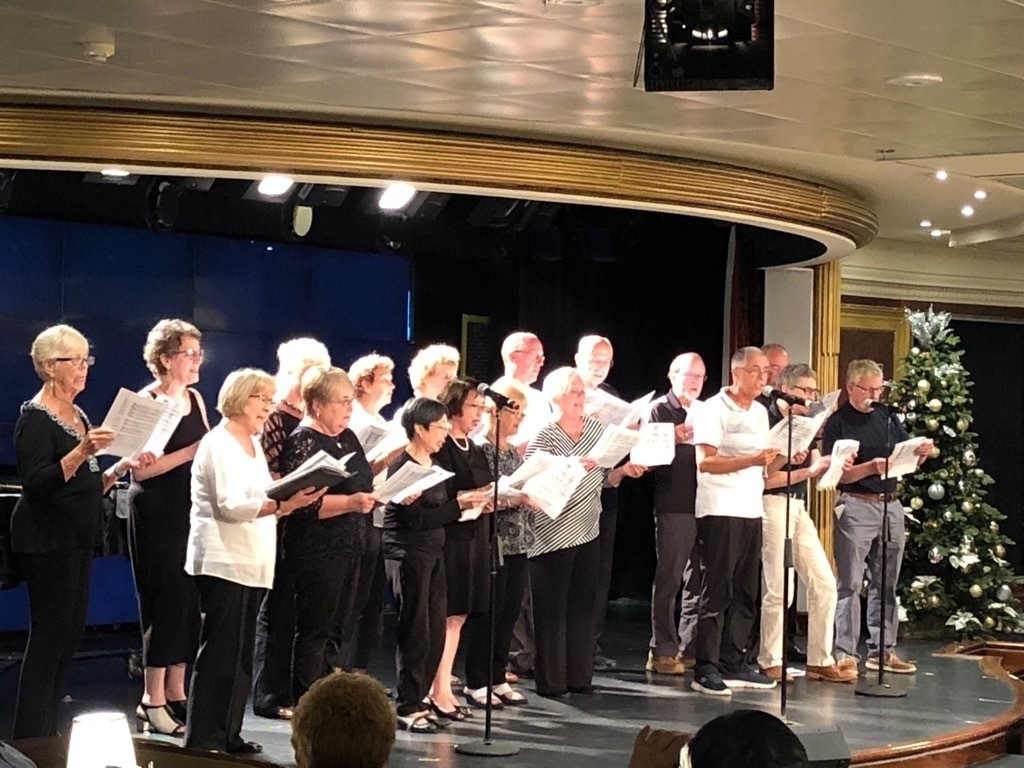

Cooking with Pearly
Cooking with Pearly
Stand under the clock tower facing the roundabout at 9:00 and my husband will find you. Those were our instructions from Pearly, our instructor for the day. So we did, Jane and I plus our two friends Rob and Joan. Pearly’s husband was a bit surprised to find Rob and Joan with us, but there was room in the class and it was no problem. Just a couple of more things to pick up at the market.
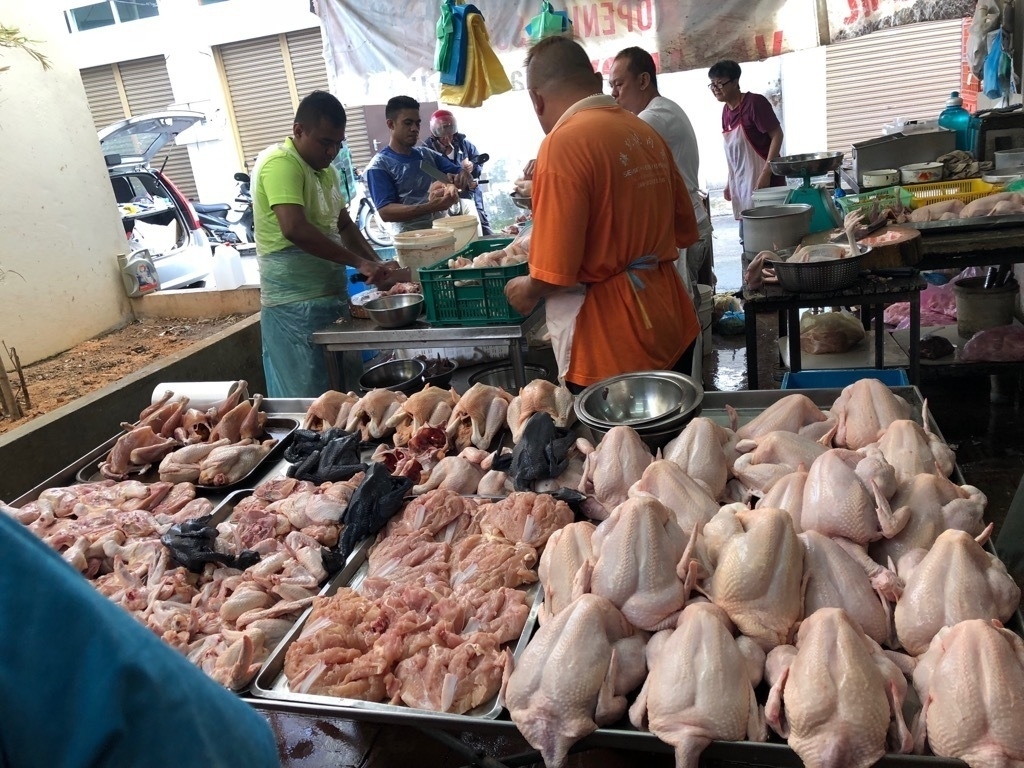
Chanda, Pearly’s husband drove us to the market where we waited for Pearly to arrive with the rest of the class. Then our lessons started. She did a great job of showing us around the market introducing us to all of the Malaysian produce. She was particularly focused on educating us about the various health benefits of all of the different kinds of root vegetables. By the time it was over I actually kind of wanted to eat a healthier diet with more greens and veggies. You read it here first folks! We also had the opportunity to try some great street food, including some peanut pancakes and some rice hoppers that were made with noodles, cane sugar, and coconut. Delicious!
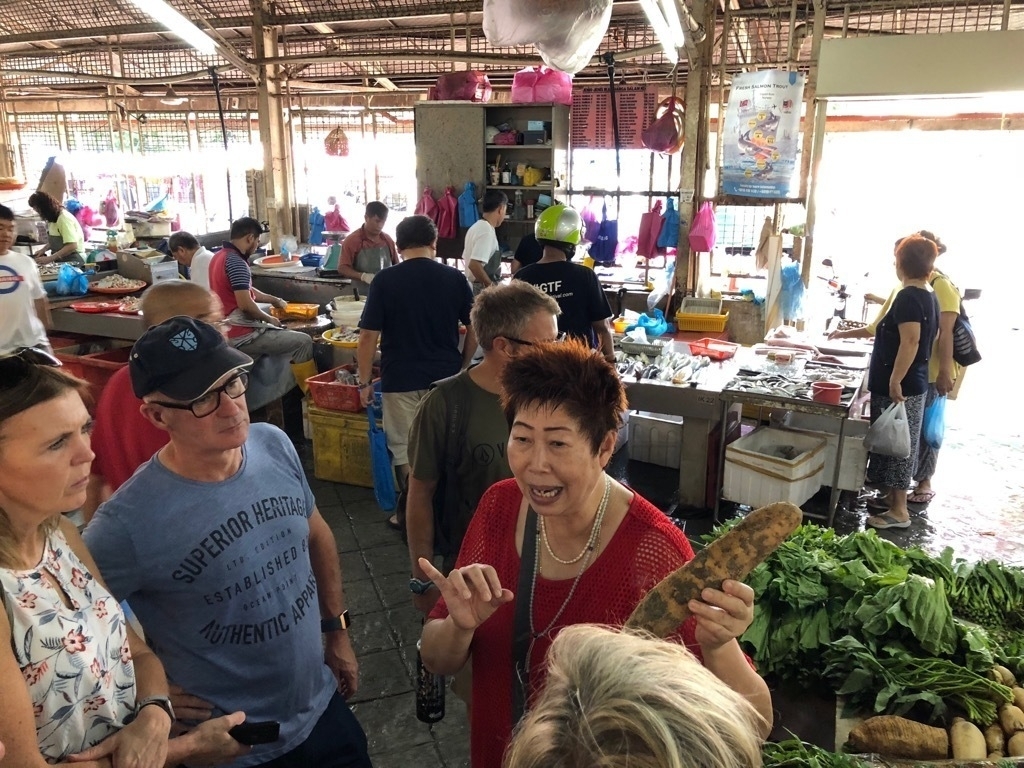

After the market tour we drove to Pearly and Chanda’s home where she gave us a tour of the garden and then brought us to our cooking stations. Since Jane and I were the first to sign up for the class we got to choose the dishes to make! We made three dishes:
- Curry Kapitan
- Sambal Goreng -- Prawns in Cashew nut sauce
- Ngor Hiang Lor Bak - 5 spice pork roll
None of these is the traditional Penang curry that we eat back home, but they are all traditional Nyonya dishes. Pearly is a fifth generation chinese living in Penang and they are the Nyonya. Over the years of cooking for the British they developed a style of cooking that was very flavorful but not as spicy as their Thai counterparts.

In each step of the work we washed everything thoroughly in a large bowl of fresh water at each of our stations. This was a little different than how I had cooked before, but the produce was all fresh and so whether it was to make sure we coaxed out any weavels hiding in the nuts or just to make sure we rinsed away any extra dirt or other nasty matter from the lemon grass or dried chilis or Galangal roots it seemed like a good idea.
When we first started it seemed like we might be in an episode of “worst cooks” as some of our classmates immediately knocked their ingredients on the ground and started cutting things up all wrong. But Pearly had pretty good humor about it and we spent most of our time laughing. She did go a little overboard at one point grabbing the spoon out of Jane’s hand in a misguided effort to “save her peppers” after her instructions about what to do were not entirely clear.
We didn’t finish cooking and eating until 2:00 in the afternoon, but the time went by very quickly.

Sunrise to Sunset in Bagan, Myanmar
Sunrise to Sunset in Bagan, Myanmar
One of the cool things about this Azamara journey is that the ship stays for three nights in Yangon (old Rangoon) which allows some of the more adventurous travelers the opportunity to do an overnight trip to the interior of Myanmar (formerly known as Burma). Our friends Ann and Jerry got us very excited about seeing the temples of Bagan so this was the perfect opportunity to do that.

Jane worked with Trufflepig travel agency to plan our days to get the most out of the adventure. Which we definitely did as we were off the ship early on our first morning in port and were were among the very last handful of passengers to board less than an hour before we sailed away from Myanmar! Our first day was a fairly nice tour of Yangon. The main attraction is the huge gold covered Schwedagon Pagoda. They were in the midst of a project they do every five years to replace the gold plating on the dome of the pagoda. We saw families dressed in their finest bringing a 10 by 10 inch plate of gold to place in a small cart that would go by wire up to the dome where it would be put in place. This must be the most expensive pagoda in the world, as the very tip of the pagoda is encrusted with diamonds, rubies and sapphire gems worth millions.
The expense of the pagoda stands in stark contrast to everything around it. It seems that people are giving away their life savings to decorate this place. Its a part of the culture that I would definitely like to understand more about. I should also point out that Myanmar is also fairly well endowed with gold mines, diamond mines as well as mines containing rubies and sapphires. But like many of our other stops there is also a huge amount of poverty.
The flight to Bagan was about an hour aboard a propjet plane, and we were met by our guide, Mr. Htay, and driver for our time in Bagan for the short five minute ride to the Aureum Palace Hotel. A beautiful 5 star hotel where the bathroom in our villa was bigger than our entire stateroom on the ship! The dining and pool areas of the hotel overlook several smaller pagoda (pagodas? pagodi?). Although it was still only around 7pm we ate dinner at the hotel. The menu was a very international menu including burmese, Thai, Italian, and American fare. Our server recommended anything from the Thai menu as the chef was from Thailand and very good. I had the Pad Bai Kra Prao Gai -- something I’m determined to cook at home. its a bit similar to Laarb but spicy instead of bright and fresh. Its ground chicken mixed with spices and spicy basil served over rice.
After dinner it was early to bed, partly because I was suffering from a nasty cold and partly because we knew we had a 4:40 alarm set to get up for our balloon ride the next morning! I slept well until 2AM and then spent the rest of the night tossing and turning waiting for that early alarm to go off, and anticipating the balloon ride! See the gallery at the end of this post for a bunch of photos.
We travelled to the launch site in a Carbus! The Carbus is a vehicle that was made in Canada and used by the Allies in World War II. At the end of the war there were 206,000 of these vehicles in Burma but it was too expensive to ship them all back home so they were just left here. Over the years the burmese have restored them, replaced and engines, and used them for various purposes. The windows were open air, or you could pull up some wooden shutters to block the early morning breeze which we did since it was the first time since leaving home that we were a bit chilly. (it was probably 69 degrees out)

We arrived at the launch site in darkness where they had coffee and tea waiting for us and then it was on to our safety briefing. As the sky began to turn gray in the east the safety briefing was over and it was time to inflate the balloons! What a fascinating process, to watch them start up fans and then run around inside the balloon making sure everything was in place. After the balloons were about three quarters inflated they started the burners and started shooting flames into the balloon, which very quickly became upright and ready for us to board! There were sixteen passengers in four compartments of the basket. The pilot, Fernando, was in the middle with his tanks of fuel and his ipads to show the wind speeds at various altitudes. it took a lot of hot air to get all seventeen of us into the air, but it was so gentle and amazing that you didn’t even realize you were leaving the ground. Once airborn we were all just mesmerized by everything! temples in every direction and the sun just peeking over the horizon.
We were probably in the air for a little over an hour and I alternated between madly taking pictures trying to capture the experience and just leaving my camera hanging so I could fully enjoy the experience! There were 23 balloons in the air that morning and part of the beauty of the experience was seeing all of the other balloons around us. It was all over too quickly when we landed (on our second attempt) in the middle of a field. Our pilot had to hold a delicate balance between letting the balloon deflate a bit versus keeping it upright enough so that the basket didn’t tip and drag until the ground crew caught up with us.
After we got out of the balloon we celebrated our journey with an early morning champagne toast. The first balloon flight was in the Champagne region of france so apparently this is a tradition followed after all balloon flights. Our pilot got into ballooning when he got fed up waiting for parts for an ultralight plane. Now he owns his own company in Spain, and spends five months of the year in Bagan doing balloon rides and five months in the south of france doing balloon rides. Quite an interesting life if you ask me!
After the balloon we returned in our Carbus to the hotel where we cleaned up, had breakfast and then met our guide for our eBike tour of the temples of Bagan. the eBike was a great way to explore the backroads around the temples. We explored a few that were off the beaten path and getting a bit overgrown, and then we saw a few of the popular ones that we had seen from the air. It was really interesting to have a good guide for this part of the trip as the walls of the temples are like history books. The different paintings and the stories they all tell always make me wish I had done more homework before visiting.


After a few hours of “templing” we drove our scooters to a monastery and had a huge burmese lunch. It is said that one of the kings in Bagan never had a meal with less than 300 dishes. We had 30. The traditional meal is to have a main curry and rice dish and then many many side dishes. We had two different beef curries and one chicken curry. That leaves 27 different side dishes. From tofu to pickled bean sprouts to mashed gooseberries to spicy toasted nuts. We managed to try a bit of everything between us. Many of them we didn’t like at all because they were just too bitter for our western taste buds. I’m not sure that even my friend (JMS) would have cleaned up all the food they served us.
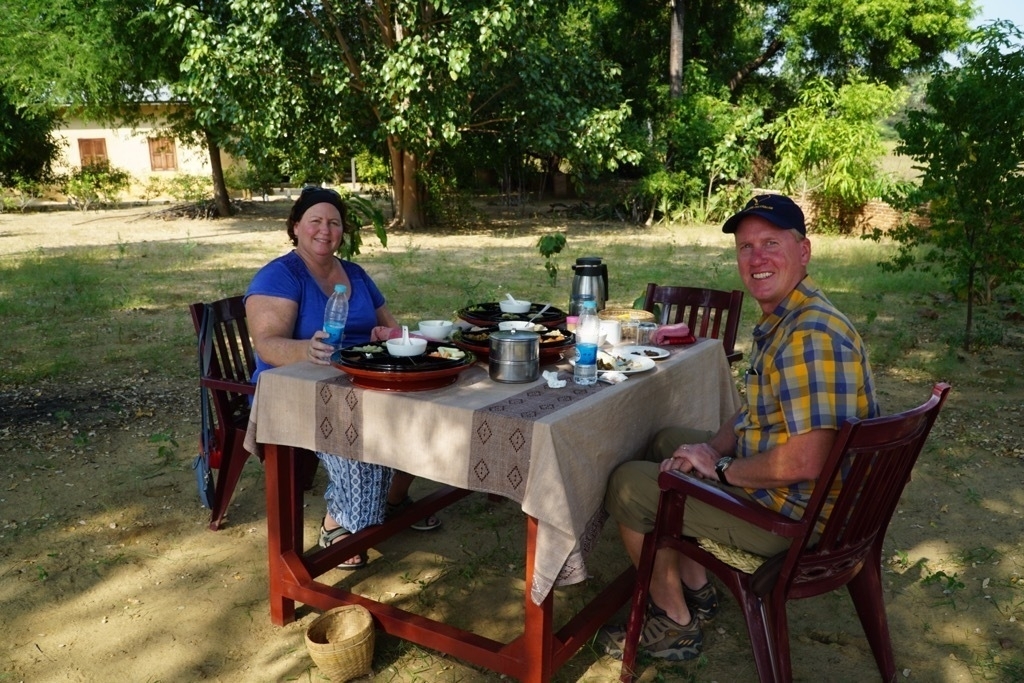
One of the best things about our guide was that he didn’t overdue the temples. After lunch he said we could continue if we wanted or we could go back to the room for some rest and refreshment before he picked us up at 4:00 for our carriage ride and sunset watching. We opted for resting and trying out the rum sour drinks from the hotel bar that our guide had recommended we sample. They were very refreshing all on their own.
The carriage ride was very peacful and the sunset was beautiful.
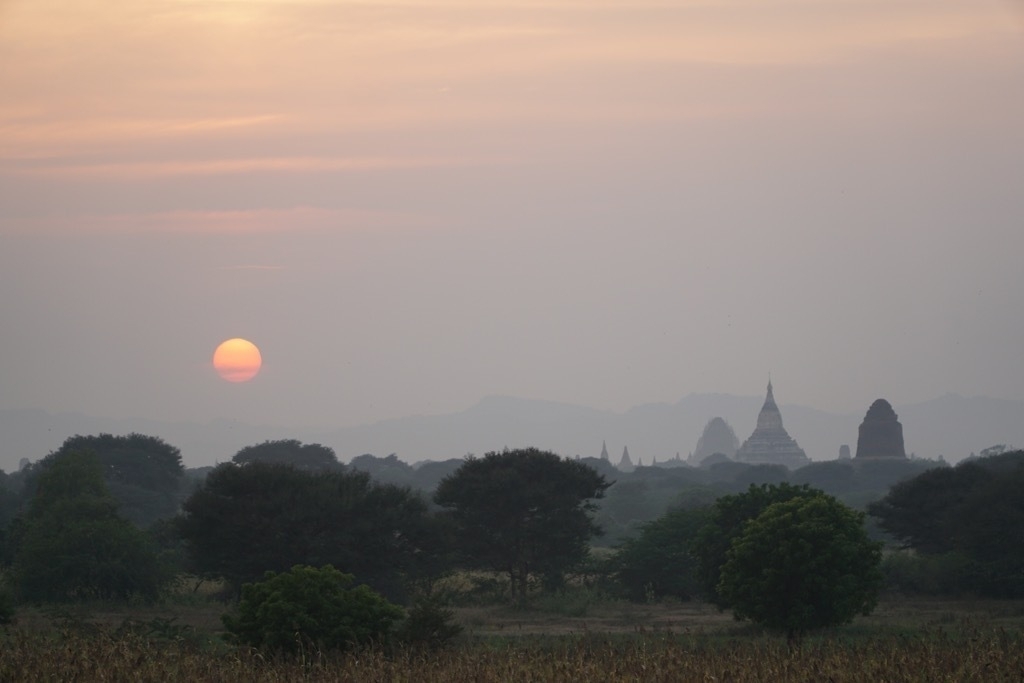
After sunset we were beat, so we had an early dinner by the pool and enjoyed the reflection of the nearby temples in pool. It was another early night to bed as we knew we were off to the airport first thing in the morning.
My one worry about the hole Bagan adventure had been that we were not leaving ourselves a very good safety margin for getting back to the ship at the end of it all. Our flight was schedule to arrive at 10:10 and the roads and traffic in Yangon are so bad that it takes at least an hour and a half to drive from the port to the airport. With our ship leaving at 1:00 I would have liked a bit more time. On top of that virtually everyone we met was flying back the night before for that very reason. Of course they all missed the sunset. So... when the time to board our plane passed and the ground crew told me that our flight was delayed by 30 minutes due to weather in Heho my stomach began to churn a bit. My internal safety deadline of 11:00 was getting uncomfortably close. Of course we knew that we had our passports and credit cards and more than a day to catch up with the ship in Phuket if we “missed the boat.” So there really wasn’t anything to worry about. But sometimes you still do even when you shouldn’t. Our plane landed at 10:50 and our guide was waiting for us. He joked that they had the privte jet all fueled up and ready to take us to Phuket, but we made it back to the ship before it sailed anyway.
Yala Safari
Yala Safari
Today we got caught up in a traffic jam in the middle of the Yala National Park in Sri Lanka! But it was for a good reason, a Leopard. After many hours of bumping around the jungle in a jeep and seeing lots of different animals we still had not seen a leopard. We really didn’t expect to as it was hot and the middle of the day. Most of the sane leopards were hidden away napping on tree branches. We knew that something was up as soon as our driver hit the gas pedal. We had learned over the course of the day that when he sped up and started driving like a madman it was because some other driver had seen something cool and it had come down their phone tree. How they tell each other their position out there is something only they know, I think, as there are thousands of paths and zero road signs.
After a few minutes of flying along we ended up at the back of a very long line of jeeps going nowhere. initially the word was that it was a crocodile, which didn’t seem all that likely as a croc would not attract this much attention. Eventually we learned that it was a Leopard! What a bonus that we were actually going to see one. After nearly a half hour of inching forward one car at a time we were pointed in the right direction by several of the guides who were standing by the side of the road trying to keep everyone moving. It was quite far in the distance but I did get a great view of it with the binoculars. Unfortunately it was too far away for any kind of recognizability unless you really zoom in like below.

Not everyone in the Jeep was so lucky and we learned a good lesson about traveling with tired and crabby people. The poor driver was just doing his job and following instructions. But after six hours in a jeep in 90 degree weather, it was a bit much for one couple who had been bickering with each other all day!
The following is a gallery of some of my favorite photos taken during the day. Enjoy! And if you ever get to Sri Lanka I recommend you plan a day like this.
Driving a Tuk Tuk in Colombo
Driving a Tuk Tuk in Colombo
This morning we had a morning at sea and we arrived in Colombo Sri Lanka noon. Jane had arranged a tuk tuk tour for us and several other people from the cruise critic message boards. We made our way off the ship and negotiated a taxi to take us to the hotel where we were to meet our drivers and tuk tuks. In case you’ve never experienced a tuk tuk it is a three wheeled vehicle with a motorcyle engine. The driver sits in the front and 2 or maybe 3 passengers sit in the back. These vehicles are all over in the cities of Asia and can drive in ways that cars cannot!

The first thing we noticed is what a different vibe there is in Colombo versus the cities in India. The driving is more orderly, the city seemed quite well maintained from the lack of garbage in the streets to the upkeep of the buildings. We visited a Buddhist temple, saw “the white house”, visited a Hindu temple, the national cricket grounds, and some of their national monuments.
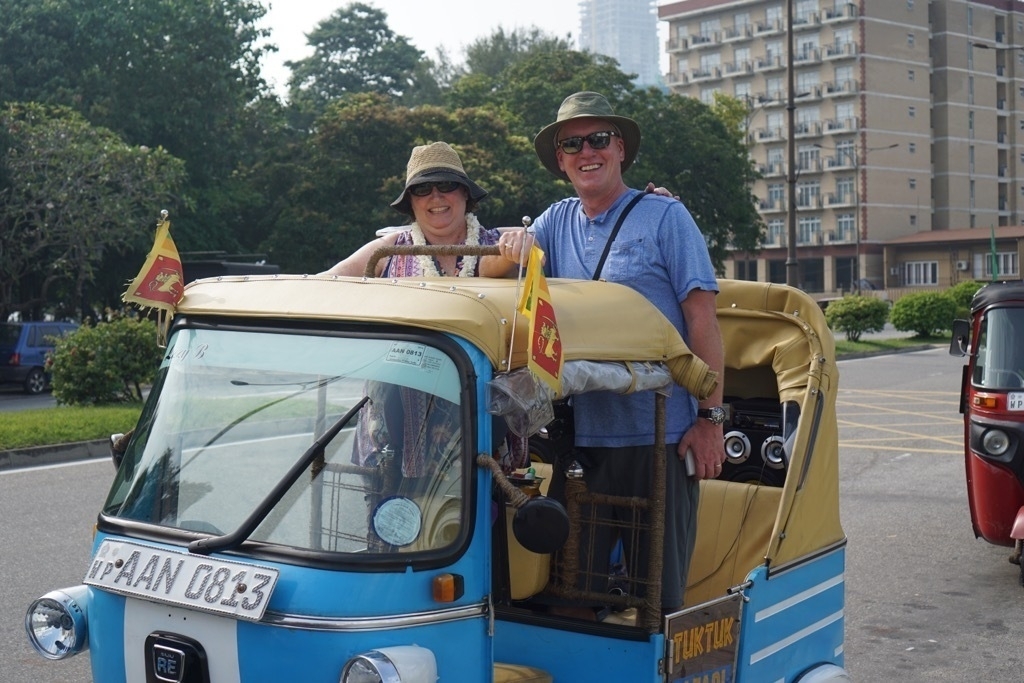
For me the highlight of the day was when we were on a pretty out of the way street and our driver pulled over and asked if I wanted to drive. Now I’m not even a motorcycle driver, but that didn’t deter me from giving it a shot. Unlike a motorcycle the clutch is on the left and along with the shifting mechanism, the throttle is on the right hand along with the break. I made it into first gear without any trouble and then paniced when I heard someone coming up from behind me. I slowed down and forgot to engage the clutch. Wah wah wah... But then we started it up again and I was good for at least 1 kilometer.
The funniest thing was that as we were motoring down the road with me driving we were passed by a policeman! It was pretty clear to all concerned that I didn’t have a license, but he just smiled and continued on his way. Jane was in the back making a video and thought the whole thing was quite funny.
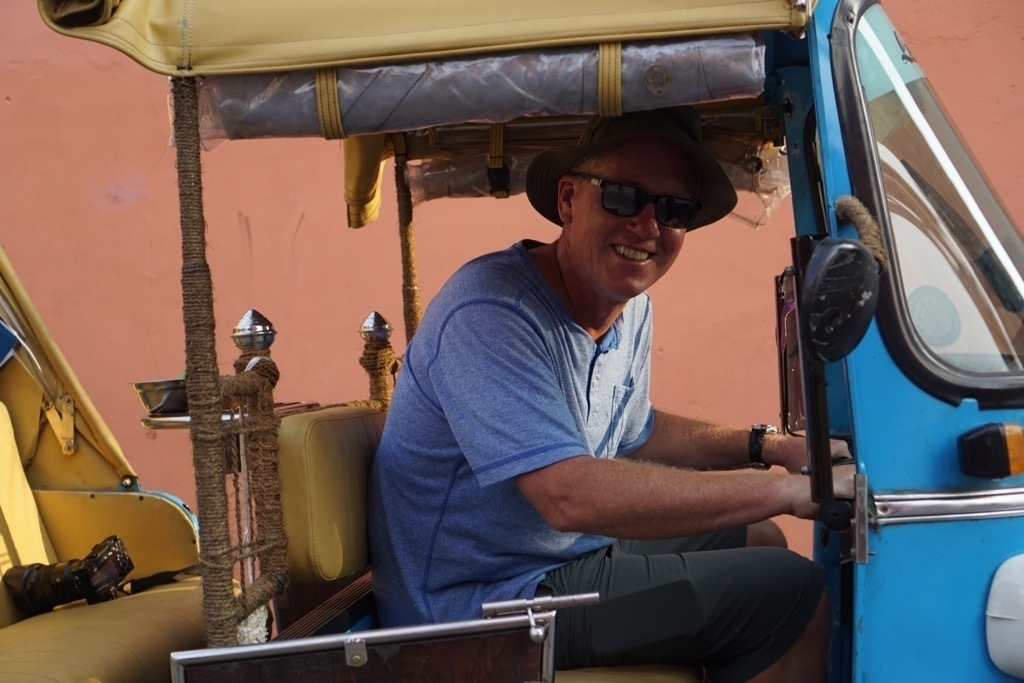
While we were at the national cricket grounds, I noticed that they had something called “Hoppers” on the menu. So I asked our guide about it. He explained that they were like crispy pancakes that you stuffed with different fillings and rolled up to eat. A few minutes later he was on the phone and arranging for us to have hoppers on our lunch stop! They were delicious. We had some spicy filling called pol sambola to use with one plain hopper and one egg hopper. Both were really good. Then we had a delicous chicken Kottu a mixture of roti and vegetables and chicken, served with a dark garlic curry. We were running a bit behind schedule but we were all so glad that we got to experience this great food instead of rushing back to the ship to make the dinner buffet! For desert we had some delicious buffalo milk curd with honey drizzled on top. Time to find a Sri-Lankan cookbook to see if I can recreate any of this at home.

Kochin: Houseboats and Driving
Kochin: Houseboats and Driving

I think that no blogging about India would be complete without some comment on the driving! It is a great example of both the chaos and cooperation present in the culture of India. It is utter chaos in that although there are line lines painted on the roads, very few drivers seem to care. Where there is only one lane you might find two or even three vehicles side by side depending on the size of the vehicles. Passing? No problem you can pull part way out of the lane to pass, the vehicle in front of you will probably move over a bit to the left and the oncoming traffic will likely move a bit to the right so you can get around! I don’t know what the statistics on traffic accidents or fatalities are in India, but amazingly we didn’t see any during our visit to either Mumbai or Kochin. I tried to make a video out the front of the bus as we were driving down the road and staring into an oncoming truck. But it didn’t turn out so you’ll just have to trust me on this one!
Our day in Kochin was mostly spent on a small bus studying the driving habits of the natives, but we did make two very interesting stops. The first stop was to do a two hour ride on a large houseboat that took us through the canals and waterways of Kochin. We got to see the countryside and the rice paddys. It was really good to get out of the city!



Our second interesting stop was at a small bridge where we could see the famous chinese fishing nets in action. These nets have been in use for centuries and it was fascinating to see them catching and hauling in the fish.

First World Problems
First World Problems
“First world problems eh?” We all use that phrase to acknowledge that when we are complaining about our iPhone being a little too slow, or our dinner selections not quite vast enough, we really do get that its not that important in the grand scheme of things. Today, we experienced life in the slum of Mumbai known as Dharavi, and it put into perspective the distance between our first world problems and real life. I don’t think I’ll use that phrase anymore as it feels like it doesn’t come close to recognizing the challenges faced by those living outside the first world.

Jane arranged our tour of Mumbai through a tour group called reality tours. They were excellent and I would highly recommend you use them if you ever visit Mumbai. Not only are the guides excellent but 80% of the proceeds from your tour dollars go straight into their community. Their community happens to be in one corner of the Dharavi slum. I was absolutely floored to learn that our tour guide for the day lived in the slum! I thought that slums were only for the very most poor and destitute, surely not for someone who was educated, well spoken and hard working! In fact we learned that many professionals such as teachers and policemen live in the slums of Mumbai. This reality runs straight against our American ideals, but we were not in America.
I’m pretty sure that we breathed som pretty toxic fumes on the first part of our tour today. The slum is divided into two parts, the commercial and the residential part. In the commercial part it seemed that recycling was a huge part of the economy, both lastic and aluminum. The plastic is broken down and then thrown into something that we Minnesotans would call a wood chipper, which breaks the plastic into smaller pieces. These pieces are then melted down and extruded into long strings and finally cut into tiny little lengths which makes little plastic pellets. These are then sold to manufacturers to be turned into who knows what. The dust and smell from the plastic can not be good for you. The same basic process is used for aluminum only that requires a lot higher temperatures. We saw a bunch of aluminum bricks that were so hot that people were cooking their lunch on them! In all of this we saw no hard hats, no safety goggles, and no shoes. We did see a lot of people working hard to earn money for their family.
In the residential area it was much different. The “streets” were so narrow that my shoulders stretched from one side to the other. The houses are quite small and for the most part families live together in a 10x20 foot room. Our guide was 30 and still lives with his parents and siblings because he cannot afford his own place. I learned that the average teacher’s salary is the equivalent of $200 per month, so it is no wonder that housing is hard to afford. Later in the day our guide took us past the most expensive house in the world a 2+ billion dollar home built overlooking the sea owned by an indian billionaire.
He explained that the government tried to clean up the slums and built hi-rise apartments next door for people to move into, but they were so expensive that nobody could afford them and most ended up moving back. Living in the slums is not free, people there pay taxes and rent and bills for water and electricity. Water only runs for a few hours a day, although electricity is pretty constant. Each home is metered for electrical use! Although the wires are run so haphazardly I can’t imagine how it is very accurate. We were not allowed to take pictures as our guide explained we are in people’s homes and want to respect their privacy. Everywhere we went, we were greeted by the children. They were all smiles and wanted to say hello to us, give us a high five or shake hands.

Another stop on our journey was the laundry. In a way this is similar to the slums in that people both live and work in the laundry. This is where the washing is done for hospitals and hotels and clothing manufacturers. We were able to take pictures inside here. Each of these large bins is one small business, doing the washing for someone.
Its all so strange and different, like a step back in time in some ways. Imagine that your hospital bedding was sterilized by throwing the sheets into a 50 gallon drum of water heated from below by an open flame!? Ironing? Of course they have ironing, have you ever seen an iron that is heated by coal? We saw some of them in use today.
So, although this part of the day was really sobering. We saw some fun and beautiful sites along the way too. The Victoria train station was very grand, and our stop at the cricket field was very entertaining. There must have been at least 100 different cricket games going on simultaneously. We watched as balls were hit across two, three, or even more other games. It seemed like total chaos to me, but it was clear that everyone was having a great time.
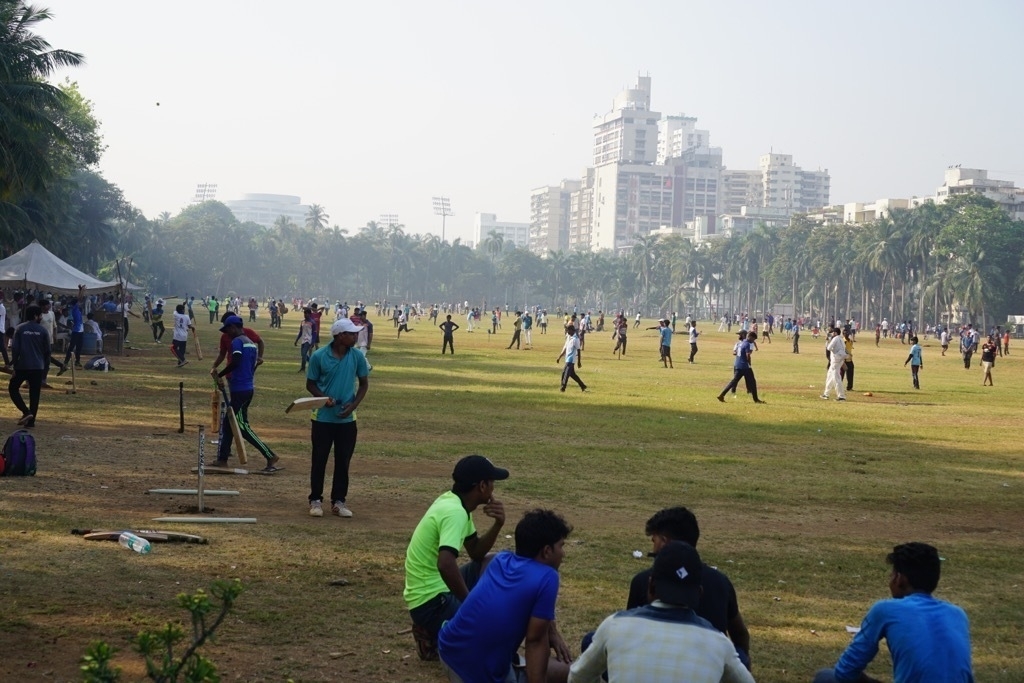
Our tour also featured a stop for some street food! We went to food stand at the beach owned by Bihm Singh, where we tried a number of different things. Pani Puri, Sev Puri and Dahi Ragda Puri. The Pani Pur and Dahi Ragda were both served in crisp little balls, where the cook punched a hole in the top and then filled the ball with delicious spicy ingredients. The Sev was more like a nacho in that it was a flat crispy bit of dough with the ingredients piled high. The way you eat these is to pop it all in your mouth at once. Jane got a fabulous photo of me demonstrating how to do this!


As far as I could tell the whole place was run on some kind of honor system. I never saw an order being written down, and yet people were eating all kinds of things chatting away and ordering and eating and chatting some more. like much of what we saw it seemed very cooperative and trusting amongst all of the participants. Such a different feel than you get in so many places back home.
I think the followup email from our guide sums up the day pretty well and since I’ve been struggling to put the day into words I’ll just quote him.
You have picked your way through Dharavi’s narrow, winding lanes, and witnessed first hand the communal, enterprising spirit that allows so many people to survive and thrive despite the many issues that they face. We hope you’ve left having had some of your perceptions about life here challenged.
To which I can only say, “mission accomplished.”
A Wadi Wadi tour of the Hajar Mountains
A Wadi Wadi tour of the Hajar Mountains
Our guide’s name was Oscar, He is a Masai from kenya, but immigrated to Dubai and works tours out of the port at Khor Fakkan. We picked this excursion because we wanted to get out of the city and into the country side. We were not dissappointed. We visited four different Emirates on our trip, but the main feature was when we got offroad and ventured through the Wadi. A Wadi is more or less a dry streambed most of the time, except for when it rains. And with less than 200 milimeters of rain a year that is not much rain.

The port of Khar Fakkan is not too developed yet. And is mostly for container ships. We had heard that it was a busy port but we were the only ship in port and there were not that many containers. We have a good alternative theory that the port that is busy is just around the corner and is the port for all the tankers. When we got a few miles away from the port we saw the oil tanks. They have a huge pipeline that brings most of the oil from the emirates to this storage facility. Its better to be here because the location is not as easily blockaded by Iran as other Emirate locations! Miles and miles of huge oil tanks, all storing oil for every brand you can think of.
We made a quick stop at the friday market. We were pretty sure that this market was just the best place they could find for a short stretch break on our way to the mountains! Our guide said we could get out and look but not to buy anything because we didn’t have any room in our jeep to haul it. He was right, although we were in a big Land Cruiser we had our guide and six passengers.

As we got to the offroad portion of the trip, Oscar became a bit upset because the lead car had taken a route he thought was sub-standard. It kept us inside the wadi instead of the better view by driving along side and above it. Finally when one car got stuck in a muddy rut (it had rained last week) he was not too happy, and both Jane and I were reminded of an earlier adventure when our airboat got stuck in the Everglades for three hours!
We also made a stop at a luxury hotel for lunch, and a very very short stop at the oldest mosque in the area. Made of clay and quite small. They were very strict about enforcing the clothing rules and since I had not heard about this part of the trip I was not allowed inside in my shorts. I could have borrowed a long traditional robe, but our stop was so short that the guides were hurrying everyone to get back in the trucks before we really figured out what was going on.
When we were getting back on the ship we figured out the reason why they were rushing us. We were in the last truck as Oscar was clearly one of the more experienced guides and was trying to keep the younger drivers in front of him. As we were going through security to get back on the ship one of the security guys was counting down. I was 8 and jane was 7 there were only six passengers (all behind us) unaccounted for before the ship could leave port.

